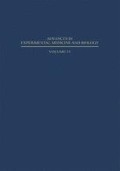Abstract
The observations summarized here arose out of a systematic examination, made for other purposes, of the effects of haemorrhage in animals of different ages, lightly anaesthetized with sodium barbitone. It became evident that in terms of the criteria detailed below, kittens and young rabbits withstood haemorrhage better than the adults of these species (10, 14). Further analysis showed that the contribution of arterial baroreceptor mechanisms in the maintenance of arterial pressure is relatively greater in adult rabbits and that mechanisms of renal origin have a predominant influence in immature rabbits (15). Both these species, especially the rabbit, are born in a somewhat immature condition. Developmental changes in cardiovascular function must be taken into account when designing appropriate tests of, and in assessing cardiovascular responses to, stimuli.
Access this chapter
Tax calculation will be finalised at checkout
Purchases are for personal use only
Preview
Unable to display preview. Download preview PDF.
References
ELOOR, C. (1964). J.Physiol. (London) 174: 163.
BROUGHTON PIPKIN, F. (1971). Quart.J.exp.Physiol.56: 210.
BROUGHTON PIPKIN, F., S.M.L. KIRKPATRICK and J.C. MOTT. (1971) J.Physiol (London) 218: 61.
BROUGHTON PIPKIN, F., J.C. MOTT and N.R.C. ROBERTON. (1971) J.Physiol. (London) 218: 385.
DAWES, G.S., J.J. HANDLER, and J.C. MOTT. (1957). J.Physiol. (London). 139: 123.
DAWES, G.S., and J.C. MOTT. (1959) J.Physiol. (London). 145:85
DOWNING, S.E. (1960) J.Physiol. (London). 150: 201.
KORNER, P.I., (1971) Physiol.Rev. 51: 312.
MCKENZIE, J.K., M.R. LEE and W.F. COOK. (1967) Nature (London). 215: 542.
MOTT, J.C. (1965) J.Physiol. (London). 181, 728.
MOTT, J.C. (1966) J.Physiol. (London) 187: 28.
MOTT, J.C. (1967) J.Physiol. (London) 191: 131.
MOTT, J.C. (1968) J.Physiol. (London) 194: 35.
MOTT, J.C. (1968) J.Physiol. (London) 194: 659.
MOTT, J.C. (1969) J.Physiol. (London) 202: 25.
SCROOP, G.S., and R.D. LOWE. (1968) Nature, (London) 220:1331.
Author information
Authors and Affiliations
Editor information
Editors and Affiliations
Rights and permissions
Copyright information
© 1973 Plenum Press, New York
About this chapter
Cite this chapter
Mott, J.C. (1973). Baro- and Chemoreceptor Mechanisms in Haemorrhage. In: Kovách, A.G.B., Stoner, H.B., Spitzer, J.J. (eds) Neurohumoral and Metabolic Aspects of Injury. Advances in Experimental Medicine and Biology, vol 33. Springer, Boston, MA. https://doi.org/10.1007/978-1-4684-3228-2_47
Download citation
DOI: https://doi.org/10.1007/978-1-4684-3228-2_47
Publisher Name: Springer, Boston, MA
Print ISBN: 978-1-4684-3230-5
Online ISBN: 978-1-4684-3228-2
eBook Packages: Springer Book Archive

